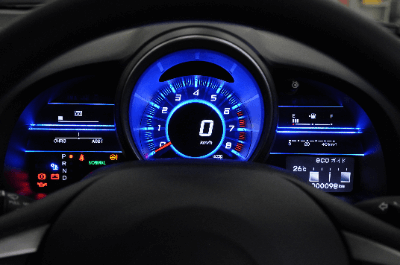What Is an Automotive Motor?
 An automotive motor meter is a general term for meters located on the instrument panel in front of the driver’s seat. It is used by the driver to check the current status of the automobile before and during driving.
An automotive motor meter is a general term for meters located on the instrument panel in front of the driver’s seat. It is used by the driver to check the current status of the automobile before and during driving.
The automotive motor meter consists of six indicators: speedometer (speedometer), engine tachometer (engine revolution counter), fuel gauge, water temperature gauge, shift position indicator, and odometer (total distance meter). In addition, there are warning lights that alert the driver to abnormalities in the vehicle. The main warning lights are a fuel level warning light, water temperature warning light, engine warning light, oil pressure warning light, and brake warning light.
Uses of Automotive Motors
The uses of automotive motors are to check the current status of the vehicle and the total mileage of the vehicle.
The speedometer is an instrument that displays the driving speed. The speedometer has a memory up to 180 km/h for domestic standard cars, and up to 140 km/h for mini cars. The tachometer indicates the engine speed. The fuel gauge indicates the amount of gasoline remaining. F” indicates full and “E” indicates no fuel remaining. The water temperature gauge indicates the temperature of the engine coolant. H” indicates overheat and “C” indicates low temperature. The shift position display indicates the current shift position. The odometer (total odometer) is an instrument that indicates the total distance traveled by the vehicle.
Principles of Automotive Motors
The mechanism of a speedometer is that a sensor is attached to the axle of an automotive motor to measure the number of revolutions, and the digital signal representing the number of revolutions is converted into a numerical value of speed by a computer. Odometers, like speedometers, are also mostly computer-controlled.
Tachometers are now mostly electric, with electronic circuits detecting the number of ignition multiplied by the signal from the engine is used to measure the number of revolutions.
In the fuel gauge, “F” indicates “Full” and “E” indicates “Empty.” The sensor sensitivity is intentionally designed to be dull in order to avoid the meter indication increasing or decreasing each time the fuel in the tank is shaken by the car’s behavior. The triangle mark on the right side of the fueler symbol indicates which side of the vehicle, left or right, the fueling port is located.
The water temperature gauge indicates the current engine coolant temperature. The “C” indicates “Cool” and the “H” indicates “Hot”. A sensor is installed in the engine coolant channel to monitor the coolant temperature.